
Birds and Orchids (part 1)
July 1st, 2017
On the 8th of June I joined Jon Ruddy and a small group of nature enthusiasts for his "Birds and Orchids" tour in Lanark County. One of the highlights was a trip to see a small Ram's Head Ladyslipper colony. You may recall mention of these rare orchids in one of my recent posts. "Small" is normally the only kind of Ram's Head colony you find, as they are rare wherever they occur. (A freak exception is a quarry in Arnprior boasting a colony of at least 150,000 of them. No one, including professional naturalists, understand why they are there.)
I had searched the Burnt Lands alvar (a known spot) for them on several occasions, but they eluded me. Now I learned why, or part of why, they are so elusive: Ram's Head Ladyslippers are tiny hidden beauties. Their "slippers" are about a centimeter and a half wide. At a glance they look like withered, past-their-prime flowers. Like nothing-much flowers. You can't even see their colors from a high angle. You have to get down low and close, and that's when the secret unfolds.
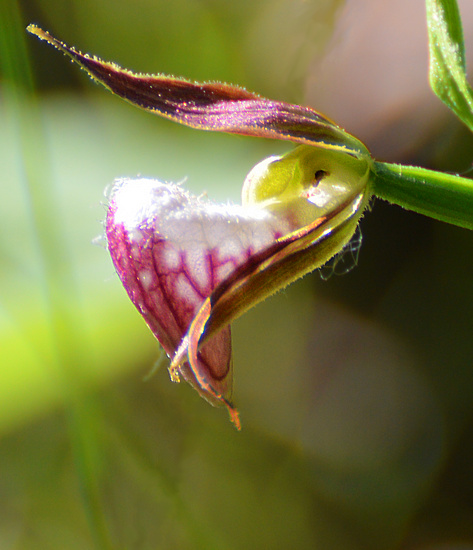
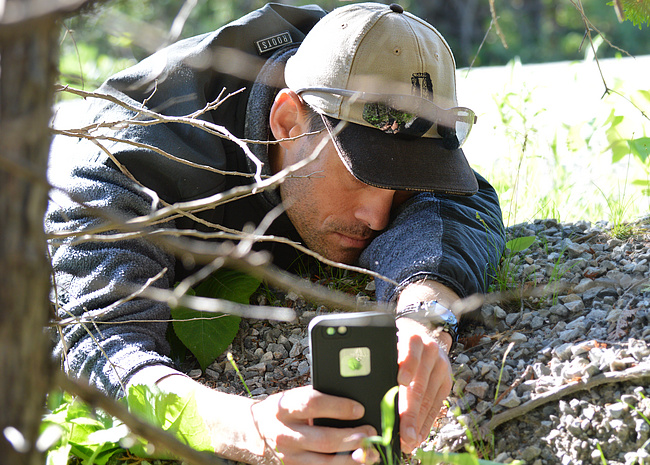
Jon photographing one of the tiny beauties
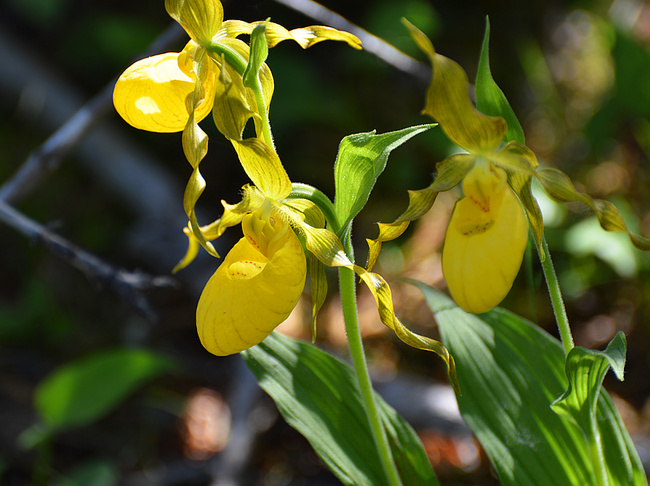
Yellow Ladyslippers grew in abundance, in clusters on the roadside. Fringed Polygala was likewise abundant, growing in the shadow of the cedars right beside the Ram's Heads. (This suggests to me that I should take a closer look at that spot in the Burnt Lands where I found Polygala. Hope I can re-find it!) This is a low-growing plant, but the polygala blossoms around the orchids almost seemed trampled, which suggested to me that this "secret" spot might not be so tightly guarded of a secret.
That's what my left brain thought, anyway. To my more romantic side, the carpet of delicate, deep pink blossoms completed the image of a fairy glade decked out for a party.

Postscript: Hiking in a different area the very next day, what should I find but two perfect Ram's Head Ladyslippers! The setting, based on what I'd learned the day before, was perfect--sunlight dappled by overhanging cedars, a floor of grass and conifer needles, Fringed Polygala and Yellow Ladyslippers growing nearby--but I'd never heard to look for them there. It was a stunning surprise.
Eastern Towhees and the Killdeer show
June 27th, 2017
In the early morning of the 7th the Burnt Lands were alive with the sound of towhees. From one spot I could hear three males singing! I'm accustomed to seeing these handsome, red-eyed sparrows only at Carp Ridge. It seems Burnt Lands may be an even better place to find them.
The nearest male tolerated me close enough for some pictures.


In previous recent outings to this park, I searched in vain for adorable Killdeer chicks. It was obvious Killdeer bred in the park--they were all over the open alvar and got agitated when I approached, scolding and doing broken-wing and fake-nest displays. But I couldn't find any chicks. This time I found out why: the Killdeer chicks were already Killdeer teenagers! At a glance they looked just like their parents. It took a closer view to reveal the subtle marks of immaturity: scruffy plumage, eyes a little paler and less colorful. This one didn't seem able to fly just yet.

Mom or dad trying to draw me off:


"This is totally my nest."

"Did I say that was my nest? No, this is my nest. Yep, tasty killdeer eggs right this way."

"Is she still there?"
( More (crane fly, columbine) )
Orchid-hunting in the Burnt Lands
June 23rd, 2017
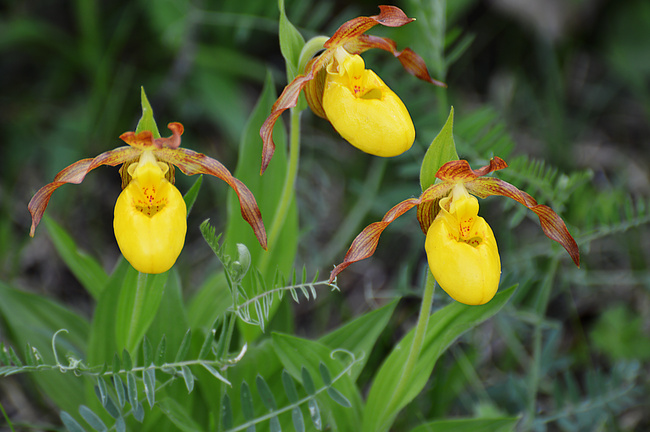
"The Three Sisters", yellow ladyslippers in bloom on the Burnt Lands alvar
In early June I made several trips out to the Burnt Lands near Almonte, hunting for orchids. For being a provincial park, this area is surprisingly unknown and unmarked, but it is an ecological gem. Last August I found it teeming with Aphrodite Fritillaries and other interesting insects (1, 2). I promised myself that for 2017, I'd go earlier in the year and seek out the elusive Ram's Head Ladyslipper, one of the rarest orchids in North America.
Last summer my usual access to the park was via Ramsey Concession 12. The maintained road ends and turns into a dirt road through the park. I found it quite hikable with only the occasional shallow puddle. However, last summer conditions were droughtlike, and conditions this year have been anything but, not to mention it's June, not August. The dirt road was so flooded (by the adjacent wetland) that even my tall rubber boots were not enough to get through it. Fortunately, there's another access at March Road and Golden Line that requires only a good set of water-resistant hiking boots.

The sign reads, "this roadway is not up to municipal standards." You don't say.
Unsurprisingly, the elusive Ram's Head Ladyslippers eluded me. But Yellow Ladyslippers certainly didn't! I found whole colonies of this beauty, most growing in the shadow of cedars and spruces, a few out in the open.
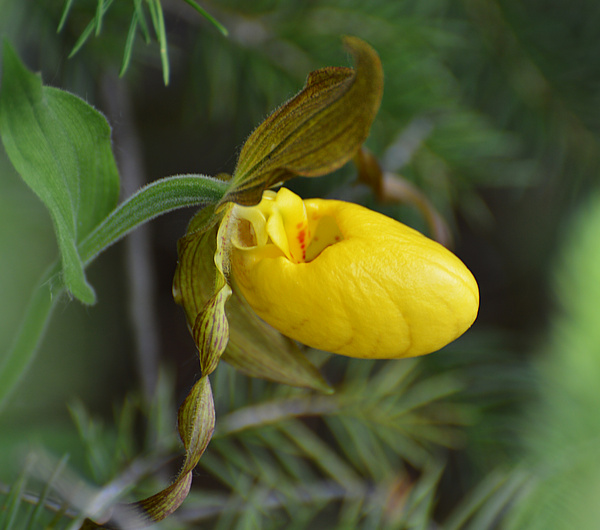
Sharing habitat with some of the Yellow Ladyslippers were patches of the most intensely blue violets I had ever seen. I wasn't sure if they were just unusually vivid common violets or something more exotic, but the fact that they hung close with the ladyslippers seemed significant. On a trip with my husband, he looked them up in our Peterson's and determined that they were indeed something a little more exotic: Northern Bog Violet. Unfortunately, my photos failed to do justice to that otherworldly blue, so I deleted them.
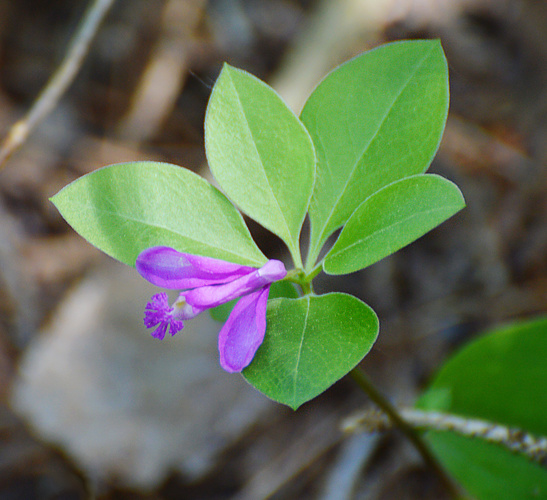
Fringed Polygala
These little beauties brightened the forest floor beneath a stand of pine trees. When I saw them I was sure I had found my second orchid of the day. They were even there in one of the orchid color plates in Peterson's, but the label said "not an orchid." D'oh! They're also known as Gaywings. The habitat I found them in (coniferous, moist) was very classic.
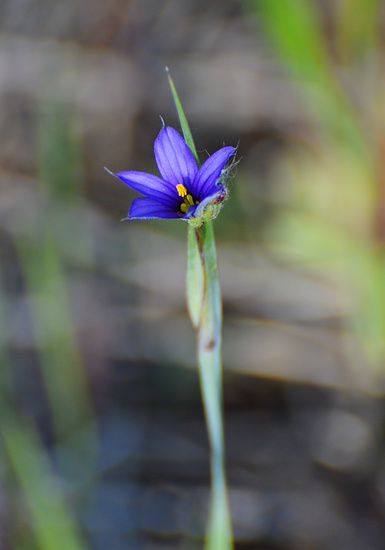
Blue-Eyed Grass
A characteristic wildflower of prairie-like habitats, this grows in the more open parts of the alvar. Though it looks like grass topped with tiny blue blossoms, it's actually part of the iris family.
( More (Wild Columbine, Blue Flag, Trumpet Honeysuckle, Seneca Snakeroot) )
Wildflowers and booming nighthawks at South March
June 18th, 2017
On May 27th I hiked the west loop of South March Conservation Forest. With the filling out of the trees, the spring ephemerals had faded--just a few lingering and wilting White Trilliums. But a fresh crop of beauty had sprung up to replace it.

1680x1050 wallpaper
Pale Corydalis grows in rocky clearings in places like South March (especially the rugged west side of it) and the Carp Ridge barrens. It is one of my favorite wildflowers. The blossoms are very small and delicate, though--you have to really get down close to appreciate their beauty.

Wild Columbine, wallpaper available

Wild Columbine

Canada Mayflower, wallpaper available

A male Rose-Breasted Grosbeak surveys his territory. South March is one of the best places in Ottawa to see these beautiful birds in their nesting habitat.
( More (Common Nighthawks, birding the tracks) )
Spring On The Rideau
June 13th, 2017
On the 19th of May I hiked the Rideau from Billings Bridge to the Hogs Back falls, photographing as I went. At Mud Lake a few days prior, I had noticed Canada Geese acting nervous and expectant around their nests. So I wasn't surprised on Friday to see this!

1680x1050 wallpaper
The surprise of the day was a different kind of goose, a Brant. It is normal to find this small, coastal/tundra goose in Ottawa in migration, but I'd never seen one on the Rideau before. It was near Carleton university.
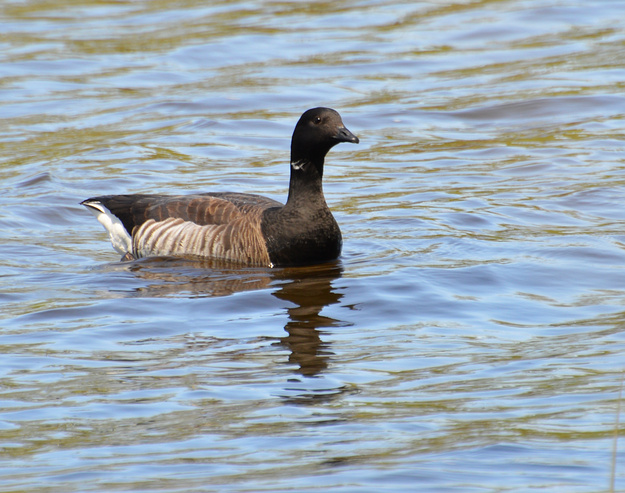
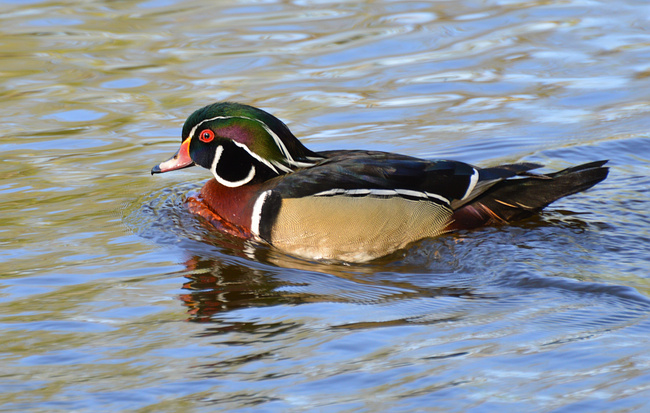
A drake Wood Duck--although you all probably know this one by now :-)

Northern Cardinal, wallpaper available

1680x1050 wallpaper
I love tulips. Who needs a composition when you have colors like that?
( More (Ring-Billed Gull, Red-Eyed Vireo) )
Living Color on the Eardley Escarpment (part 2)
June 4th, 2017
(Part 1)
As I was hiking back I heard the distinctive "chick-burr" of a Scarlet Tanager. Scarlet Tanager is an amazingly red little bird (the males are red, that is, females are yellow) that, frustratingly, spends almost all its time at the tops of tall, leafy deciduous trees. I enjoy them through binoculars every year, in places where they breed (South March Highlands, Gatineau Park, and even parts of Stony Swamp), but never once have I gotten a photo worth showing. But as I reached the spot where the "chick-burr" was coming from, I was delighted to see a male tanager swooping down low...and then amazed when he came lower, and lower, until he was actually on the ground! I think that he was likely guarding his mate as she gathered nest material. I can think of no other reason for a Scarlet Tanager to go to ground.
Of course I took pictures. He was distant and tricky to get in focus--and photos never entirely do justice to this bird (ideally you need to be there, with a good set of binoculars, looking up at the reddest thing you ever saw, a bird that honestly seems to glow red, thinking "my god, am I in tropical South America or am I still in Canada?") But these are certainly the best adult male photos that I've ever obtained.


Surprise number two happened further back down the trail, when I came to a spot where the underbrush was just positively alive with very tiny, very fast-moving creatures. There were many small openings in the brush, at the base of a tree trunk, under logs, etc., and they darted in and out of those openings at the speed of light, never in view for more than a fraction of a second. I struggled to even see them clearly, much less photograph them.
Finally, I pointed my camera at one of the tree holes that they were scurrying in and out of, and rapid-fired my shutter, producing about twenty pictures of an empty hole and one picture of this! (To give an idea of scale, the hole was maybe an inch and a half wide.)

That's a shrew--one of the tiniest mammals in the world, even smaller than a mouse. Shrews aren't rodents, but miniature carnivores, most closely related to moles, who eat insects, spiders, amphibians, small rodents, and even other shrews. Their frenetic activity and voracious appetites are supported by a super-charged metabolism which rivals that of a hummingbird: a shrew can starve to death within a few hours without food.
Sadly, there are a number of lookalike shrews in Ontario so there is no way to determine the exact species of this one. The likely candidates, I'm told, are Smoky Shrew, Common Shrew, and Short-Tailed Shrew.
Living Color on the Eardley Escarpment (part 1)
May 29th, 2017
On May 17th I went hiking in the Gatineau, taking the old McCloskey Road trail to McDonald trail and up to the Western Lodge. The display of spring ephemerals was even more outrageous than it was at nearby Wolf Trail last spring! The woods were like a garden. An endless profusion of Red Trillium, White Trillium, Trout Lily and Bellwort, with a little Bloodroot here and there, swampy spots overflowing with Marsh Marigold, and more besides. I came mainly to photograph the flowers--the birds of Eardley Escarpment are multifarious and good, but usually too far up in the trees for my lens to capture. But, as it turns out, there were a few surprises.
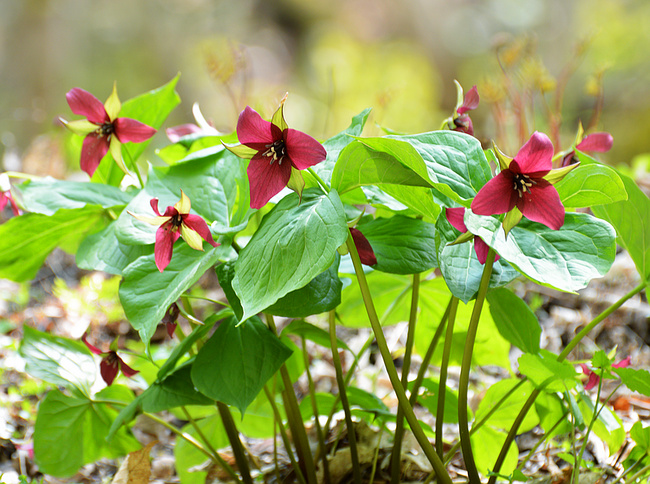
Red Trillium, wallpaper available

Red Trillium, wallpaper available

Trout Lilies

Bellwort

Bloodroot

These Marsh Marigolds formed thick golden carpets in swampy spots. I can't remember seeing them in such profusion before. I guess our very wet spring created good habitat for them!
Next up, the day's two surprises.
Upstaging The Warblers
May 23rd, 2017
I continue to be cursed for warbler photography at Point Pelee.
On the first day of our outing, there were lots of warblers, but almost none of them were out on the tip (where you can sometimes get extreme close-ups as these exhausted birds, having just flown across Lake Erie, drop into the low vegetation and, well, veg.) They were in places like Tilden Woods, flitting around high up in the trees. It's great for them that conditions were so good they could just breeze right past the tip and into the woods, but not so great for photography, especially not with my modest 300mm lens. I had a much better time (and saw more birds) once I finally stowed my camera away and went back to just binoculars. I saw seventeen types of warblers all in all, of which the highlights were a nice view of a Blackburnian, and an excellent view of a Northern Waterthrush.
The second day was much better, or so I'm told. Unfortunately I wasn't there, for reasons I won't go into.
But the trip wasn't a complete loss for photos. When we arrived at the tip of the tip, I was thrilled to see a number of Red-Breasted Mergansers, males and females, swimming close to shore. My group was eager to move on and find a rumored Tufted Titmouse, but I see all the titmice I need when I visit my folks in Virginia, and I don't see nearly enough of this unusual, charismatic duck--especially the drake in his full nuptial plumage. So I lingered behind, missed the titmouse, and got some photos of the nearest drake as he showed off for the ladies.

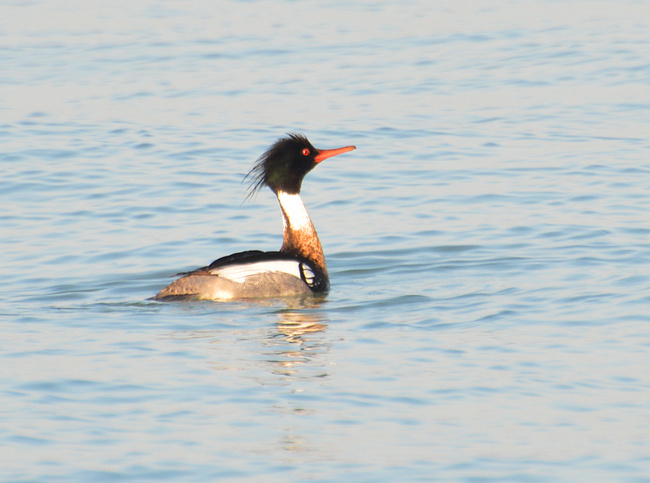

I also think this early-morning Barn Swallow came out rather well. A whole colony of these swallows breed in an open shelter near the tram stop, building their mud nests on ledges beneath the ceiling. They are completely habituated to humans, whizzing back and forth to and from their nests right over our heads.

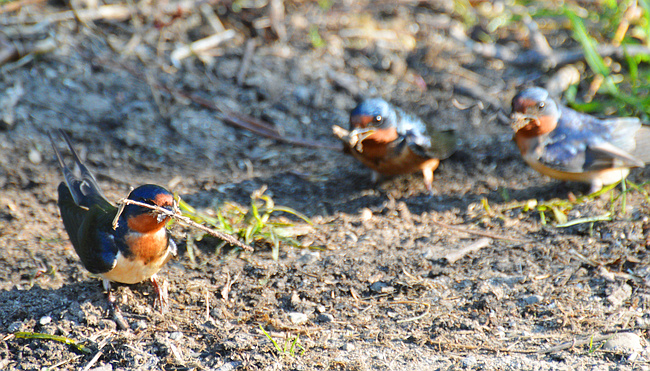
Gathering nest-building material.
Our disaster, their wonderland
May 19th, 2017
I went birding at Mud Lake on Wednesday the 10th. It was like no visit to Mud Lake ever before, and probably none hence. (For those of you in Ottawa, you maybe heard in the news about "flooding in Britannia"? Yeah. Britannia is where Mud Lake is.) I felt quite confident heading down the trail with a pair of knee-high rubber boots on. But even thus equipped I was unable to complete the loop.
The pond (connected with the swollen Ottawa River) had simply taken over. For large swathes of the trail, there was no trail. There were ducks paddling and fish swimming where there had once been a trail. And the Rusties, oh my god, the Rusties. Rusty Blackbirds, as I mentioned in my last post, are a species of icterids who love foraging on flooded ground. The rich brown coloration that gives them their name is only seen in fall and winter. By this time of year, females are charcoal and males are glossy black, with striking pale eyes, like miniature short-tailed grackles. In good light they show a steel-blue sheen. They are largely birds of the boreal forest and muskeg, breeding north of us, and their population is in decline. Normally if I see a few of them in a year I'm happy.
Mud Lake was dripping with Rusty Blackbirds, far, far more than I'd ever heard or seen. To them it was a wonderland. Anywhere there was water where there shouldn't be, there they were, strutting along the margins of the flood or perching over it, and filling the air with their odd, stuttery, gurgling songs. As I splashed my way down the "trail" I could see the flocks retreating before me--but now and then a straggler granted me a photo op. I was in heaven seeing, hearing and photographing so much of a bird that is usually elusive to me.
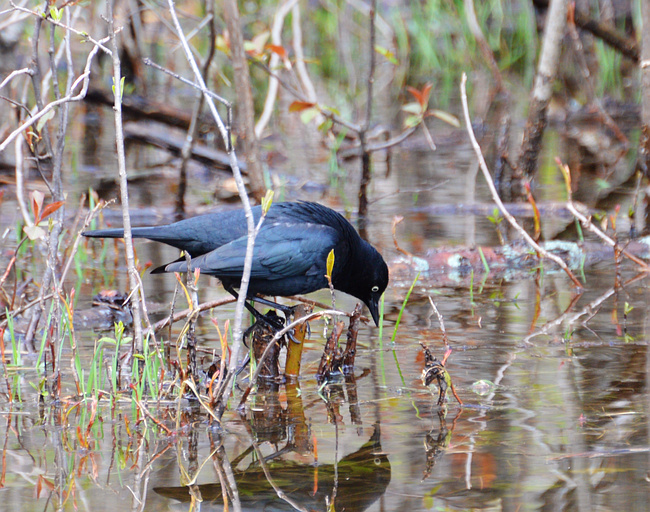
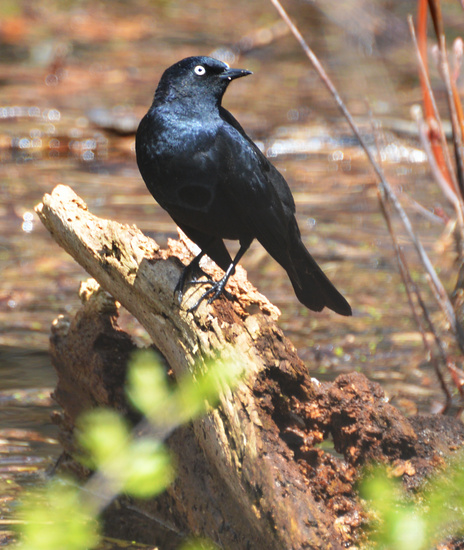

That was a trail once.

The west entrance to the ridge.
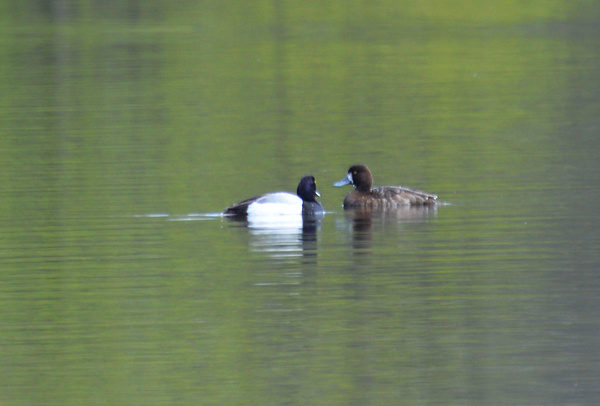
Another sign that we're not in Kansas anymore: a mated pair of Greater Scaup on Mud Lake. These are diving ducks who prefer fairly deep water. They show up mainly on large rivers (like the Ottawa) in migration, and breed on large lakes--actual lakes, which "Mud Lake" isn't. But in its flooded state, it must have looked like decent habitat to them!
( Continue (Rusties galore, a couple of warblers, trout lilies and more!) )
Of floods and falcons and other spring adventures
May 3rd, 2017
It's been a weird, wet, interesting spring.
In early April I made the traditional Ottawa birder's trek out to Cobb's Creek floodplain, near Bourget. Each spring Cobb's Creek floods and turns the surrounding fields into a shallow lake, attracting migrant waterfowl. I went twice, first solo and a few days later with Mike. On my solo trip I found the water mostly iced over, although that didn't dissuade the tens of thousands of Snow Geese! Few ducks to be seen, though.
I decided to go hiking down the old railbed trail. Not far down I found a long-tailed, light gray bird, singing away. Its song was a rather random-sounding series of phrases, some repeated. Well, I figured I knew what that had to be: my first Ontario mockingbird! I see mockingbirds galore whenever I visit my parents in the southern states, but it was still exciting to see one close to home, where they are quite rare.
But then I twigged to something...what was with that dark streak through the eye? Mockingbird doesn't have that. Then the "mockingbird" flew and alit on another tree in much better lighting, flicking its tail, and my mistake became clear. Black mask, hooked bill, faintly barred breast: not a mockingbird but a Northern Shrike. Though this was not an Ontario first, it was just as exciting, simply because I'd never found a shrike singing before. Shrikes are oddities of evolution, carnivorous songbirds that actually catch and eat other birds (and rodents.) Lacking sharp talons to hold onto their prey, they have developed the grisly habit of impaling it on barbed wire or a thorny branch. Chickadees dread them. It seemed so surreal for this fierce raptor (well, pseudo-raptor) to be singing cheerily!
A few days later I went back with Mike, and all was changed. The ice was off the water, and the water had swelled to become the most impressive flood I'd ever seen. It actually had waves. It had positively overshot the water level preferred by dabbling ducks, so again, there were few to be seen. Instead of duck-watching we ended up muskrat-watching! Hard to believe how many of them were paddling around in there.
In mid-April, around the time when Michael and I were contending with our flooding basement window well, I went hiking at Shirley's Bay and came to a spot where the river had simply swallowed the trail whole. Rubber boots would not have sufficed, hip-waders may have sufficed, but frankly, I'd put my money on a canoe. So I turned back, but not before having seen a wealth of migrant birds, including the largest group of Rusty Blackbirds that I'd ever found in spring. Rusties are grackle-like blackbirds (but smaller and shorter-tailed) who forage for food on swampy, flooded ground. Is it a coincidence that this is the spring when I see my biggest spring group of Rusties ever? I doubt it.
At the end of April, we hiked the Rideau from Billings Bridge to Hog's Back Falls and back. Highlights included a male Red-Breasted Merganser acting surprisingly pair-bonded with a female Common Merganser, and a Double-Crested Cormorant in resplendent breeding plumage, with an all-over indigo sheen and a gular pouch so strikingly yellow it looked painted. (Cormorants only look like that for a short time each year. In fact, seeing this bird made me realize that much of what I admired about the Great Cormorants in Cape Breton was due to finding them at peak season, and not due to their particular species.)
But the big highlight came near Billings Bridge, as we were walking back through the park lawn and a long-tailed light gray bird flew into a bush, flashing white wing patches. "I'm pretty sure that was a mockingbird," I told Mike.
"You're kidding," he said.
Since I had recent experience of mistaking a shrike for a mockingbird, I didn't want to be cavalier. So we waited patiently until the bird finally flew out, perched in a tree, and gave us a good look. There was then no question. Ontario-first Northern Mockingbird, for real this time! I reported it on Ontbirds, and about an hour later, it had been re-found by Paul Mirsky. Two others reported it early the next morning. This was exciting for me, as I don't often get to be a first finder of rarities, and the last time I was (the European Goldfinch at my feeder in 2015), the bird split before anyone other than me and my husband got a chance to enjoy it.
That brings me to this morning at Mud Lake, where I found the trail flooded in places it has never flooded before. (This is going to end eventually, right? We're not going to need an ark?) It was a cold morning with very few spring migrants to be seen, but one sighting from Cassels Road made my day by itself. All the Red-Winged Blackbirds in the vicinity began making alarm calls, and then a large raptor swooped in and started circling. When you see a raptor flying over Mud Lake you expect a Cooper's Hawk or an Osprey, maybe a Merlin (a small falcon) if you're lucky. This bird was definitely a falcon by shape, but it outsized any Merlin and had the thick black sideburns of the Merlin's more famous relative, Peregrine Falcon! And now that it was overhead the blackbirds were making sounds like I had never heard them make. (If you are familiar with the redwing's usual piercing alarm call, imagine that, but furtive and muted instead of piercing, with a certain "oh shit" quality about it.)
Then it actually went into a stoop: it dove down at the water, veering up at the last minute. But I couldn't see anything there that it would have been stooping at. Maybe a young falcon practicing its moves?
Coming soon, rain with more rain and a side of rain. And coming hopefully after all that is over with, my big four-day trip to Point Pelee with Jon Ruddy.
|
